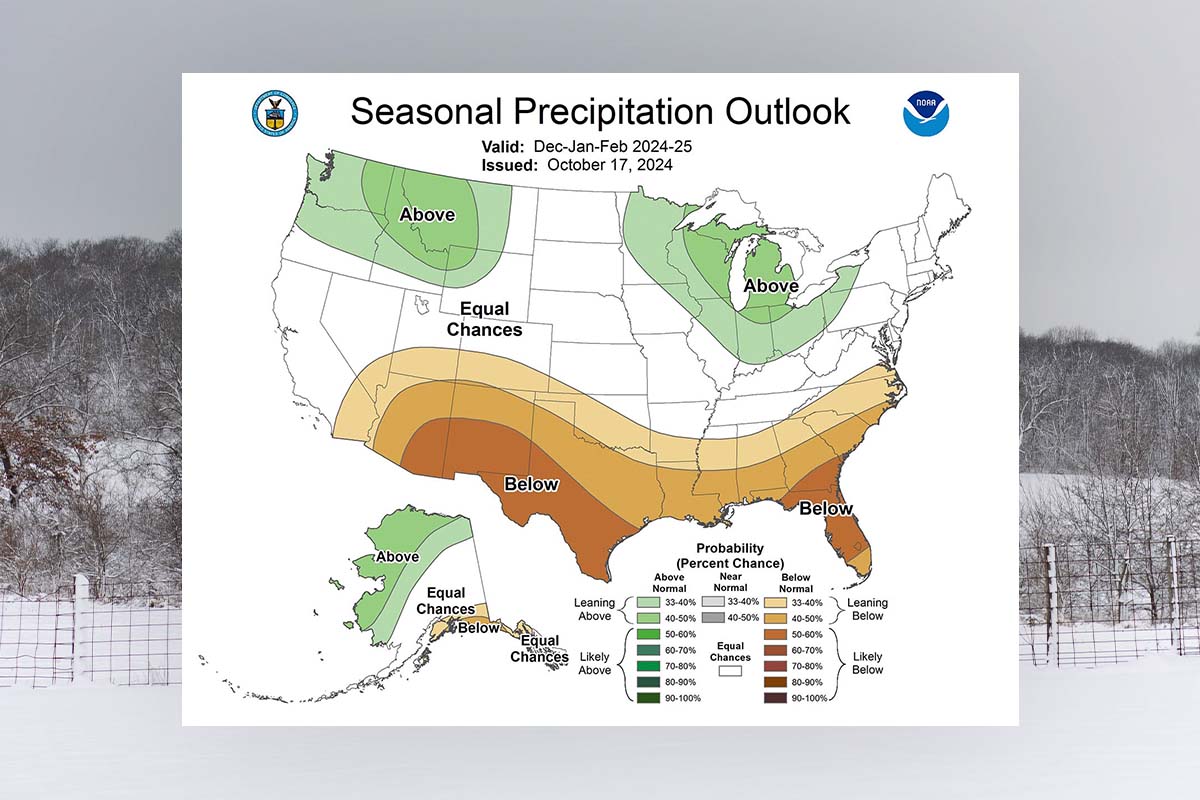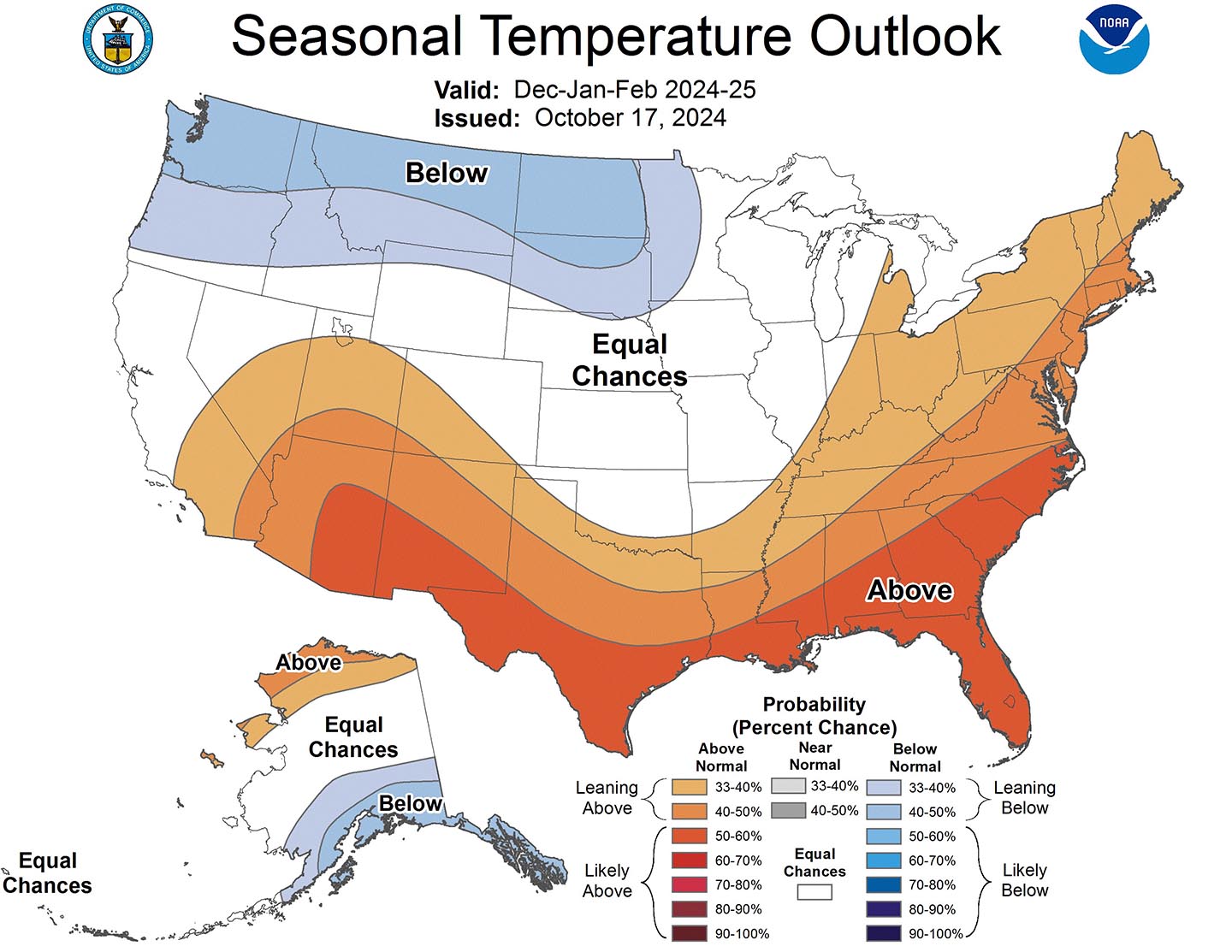
(Photo: National Oceanic and Atmospheric Administration)
Winter forecast is anything but clear
October 31, 2024
Will there be snow-covered fields this winter to help replenish some of the needed moisture Iowa farmers are asking for? Or will mild temperatures and a lack of precipitation mean drought conditions will continue into early 2025?
If you ask the meteorologists, the prognosticators or just about anyone with an opinion, the answers are vague at best when it comes to predicting Iowa’s winter forecast.
According to the latest three-month (Dec. 2024 through Feb. 2025) forecast from the National Oceanic and Atmospheric Administration’s (NOAA) National Weather Service (NWS), a slowly-developing La Nina is favored to influence conditions for the upcoming winter.
Come December, NOAA predicts wetter-than-average conditions for the entire northern tier of the continental United States, including the Great Lakes region. Meanwhile, drier-than-average conditions are expected from the Four Corners region of the Southwest to the Southeast, Gulf Coast and lower mid-Atlantic states.
Stuck in the middle is Iowa where the forecast calls for equal chances of below-normal, normal or above-normal precipitation and temperatures.
La Nina conditions are expected to develop in the next several weeks which typically lead to a more northerly storm track during the winter months.
And while the forecast is not clear as to Iowa’s winter weather fate, NOAA forecasters do expect drought conditions to persist and worsen across the central and southern Plains.
“Unfortunately, after a brief period in the spring of 2024 with minimal drought conditions across the country, more than a quarter of the land mass in the continental United States is currently in at least a moderate drought,” says Brad Pugh, operational drought lead with NOAA’s Climate Prediction Center. “And the winter precipitation outlook does not bode well for widespread relief.”
‘Equal Chances’
Justin Glisan, state climatologist of Iowa, says it’s clear there is no certainty as to what farmers might expect in terms of this winter.
“Right now, short-term outlooks into November show higher probabilities of warmer than average temperatures and a slightly elevated wet signal,” he says. “We are also in a ‘La Nina Watch’ with a 60% chance a transition to this phase in the October-November timeframe.”

Glisan says confirmed NOAA’s assessment that typical La Nina winters are colder across the Dakotas through Montana and the Pacific Northwest. The southern states are generally warmer and drier.
“We don’t have clear guidance for Iowa, as we are categorized in “Equal Chances” of above/below/near-average,” he says. “However, in weak La Nina winters, we have generally experienced above-normal seasonal snowfall totals across much of the state.”
Glisan says from 2020-22, Iowa experienced three consecutive La Nina winters, which is only the third time this has happened since 1950. With 152 years of records, they ranked as such for temperature/precipitation:
- 2020: 23rd warmest/ 62nd driest
- 2021: 63rd coldest/52nd driest
- 2022: 69th warmest/16th driest

The value of snow
While most Iowans would argue having to dig out from heavy snow can be a pain, most farmers agree there is value to having a good layer of snowfall on their farm fields.
Snowfall cover can help with:
- Improving soil moisture: Snow helps the ground retain moisture, which is important for plant growth. Heavy wet snow can add a significant amount of moisture to the soil.
- Reduce erosion: Snow protects the soil from being blown away by strong winds.
- Insulate the soil: Snow acts as an insulating blanket that traps heat and prevents frost from penetrating the soil. This allows the soil to thaw more quickly in the spring.
- Trap nutrients: Snow can trap nitrogen, nitrate, and ammonium from the atmosphere.
- Livestock: Those farmers who raise cattle can get much of their water from snow when grazing on winter pasture.
- Barge traffic: Given that the Mississippi River remains significantly below normal levels for the third year in a row, snowfall could help lift those numbers. When major waterways are high enough, barges can ship more soybeans, corn and other cargo to the Gulf of Mexico.
Almanac predictions
So, will it be a White or Brown Christmas?
According to The Old Farmer’s Almanac, Iowa and other Central Plains states will see a warmer than normal winter with below-normal precipitation and snowfall.
The coldest and snowiest periods will occur in late January, as well as early and late February.
As for spring planting in 2025, the publication says April and May will be warm with below-normal rainfall.
Back